The South Platte River once supported the growth of an entire region. Cities and civilization all along the river’s shoreline sprang up, igniting the West’s development. Now, everything from shopping malls to fields of corn relies on the water in the South Platte River. Today, the South Platte Basin is tasked to support over 2.8 million people in a three-state area—and roughly 95 percent of those people live in Colorado. This is largest population density in the Rocky Mountain region and has led to the overuse of the crucial South Platte water supply.
But the communities that have used, and at times severely depleted, the resource are now working to restore it and bring the river back to health.
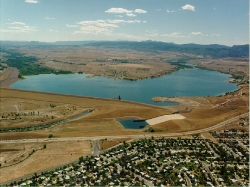 It was announced last week that Denver Water, with help from Colorado Parks and Wildlife has obtained the rights to an additional 2,100 acre-feet of water that will be stored in Chatfield Reservoir and will be released downstream during times of low flow. The additional water will address the river's fishery and the populations of trout.
It was announced last week that Denver Water, with help from Colorado Parks and Wildlife has obtained the rights to an additional 2,100 acre-feet of water that will be stored in Chatfield Reservoir and will be released downstream during times of low flow. The additional water will address the river's fishery and the populations of trout.
With the additional flows during low water periods, the water temperature will remain lower and deeper pools will be created, allowing a more hospitable environment for rainbow trout.
Increasing water flows is just one step of many that has been done to help revive the river. The Denver Trout Unlimited Chapter has been working on restoring the South Platte for many years. The chapter has recently installed water temperature sensors from Chatfield Reservoir upstream through Downtown Denver and all the way to Commerce City. These monitors will allow the chapter and agencies to see how the sometimes unreliable flows affect the temperature of the South Platte and influence the fishery.
The river also benefits from the CarpSlam- an annual fundraiser that focuses on anglers catching carp through Denver. The funds raised by the CarpSlam go directly towards the South Platte and restoring the health of the river. Over the years, the CarpSlam has resulted in anglers catching Carp, Walleye, Bass, and Trout in a river that some believe isn't able to hold a healthy population of fish.
 Projects like Stream Explorers have also helped the South Platte by teaching students about the river and how it is used for both human and aquatic needs. Learning how a city can impact the health of a river and how the river plays such a vital role to our way of life is important to teach to the next generation of river stewards.
Projects like Stream Explorers have also helped the South Platte by teaching students about the river and how it is used for both human and aquatic needs. Learning how a city can impact the health of a river and how the river plays such a vital role to our way of life is important to teach to the next generation of river stewards.
Through all of these initiatives by Denver TU, Colorado Parks and Wildlife, and Denver Water, the South Platte River is returning to a healthy river. One that not only provides water for municipal uses but one that offers enough cool, clean water for a healthy population of trout and other fish species.







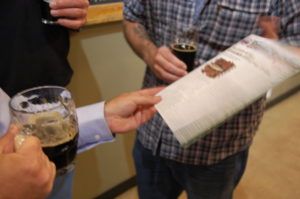
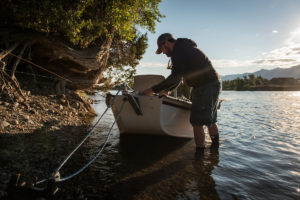 It is believed that the parasite causing the fish kill was introduced to the river by people and FWP along with Montana TU and its chapters are urging people to keep their gear cleaned. "Now that the parasite (Tetracapsuloides bryosalmonae) is in the Yellowstone and infecting fish, the main priority is eliminating additional stressors on those fish and preventing it from spreading to other rivers," said David Brooks,
It is believed that the parasite causing the fish kill was introduced to the river by people and FWP along with Montana TU and its chapters are urging people to keep their gear cleaned. "Now that the parasite (Tetracapsuloides bryosalmonae) is in the Yellowstone and infecting fish, the main priority is eliminating additional stressors on those fish and preventing it from spreading to other rivers," said David Brooks, 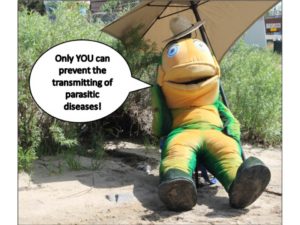
 The Western Native Trout Initiative (WNTI) has granted Colorado Trout Unlimited and the Cheyanne Mountain Chapter of Trout Unlimited $6000. Two $3,000 grants will be used to help bring public awareness to native trout and help further greenback genetic studies at Mt. Shavano Fish Hatchery. Western Native Trout Initiative is an organization dedicated to protecting native trout. They offer many different grant opportunities that provide conservation organizations with a means to realize their native trout projects.
The Western Native Trout Initiative (WNTI) has granted Colorado Trout Unlimited and the Cheyanne Mountain Chapter of Trout Unlimited $6000. Two $3,000 grants will be used to help bring public awareness to native trout and help further greenback genetic studies at Mt. Shavano Fish Hatchery. Western Native Trout Initiative is an organization dedicated to protecting native trout. They offer many different grant opportunities that provide conservation organizations with a means to realize their native trout projects.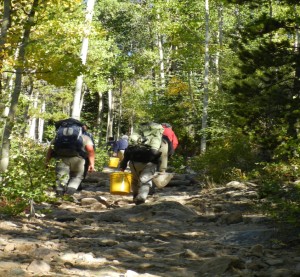
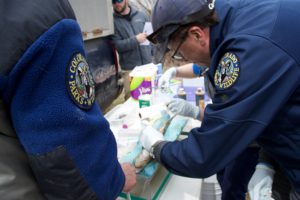
 There was no fish mortality documented from the spill, while bug sampling by an aquatic biologist with Mountain Studies Institute indicates a still thriving population of mayfly nymphs and caddis pupa. Colorado Parks and Wildlife (CPW) had installed pens of fingerling trout in the Animas before the plume arrived- and none of those fish died either. CPW ran an electro-shocking episode after the “Spill” with the usual re-capture protocol and got essentially the same results as the year before. Actually, the survey showed a slight improvement.
There was no fish mortality documented from the spill, while bug sampling by an aquatic biologist with Mountain Studies Institute indicates a still thriving population of mayfly nymphs and caddis pupa. Colorado Parks and Wildlife (CPW) had installed pens of fingerling trout in the Animas before the plume arrived- and none of those fish died either. CPW ran an electro-shocking episode after the “Spill” with the usual re-capture protocol and got essentially the same results as the year before. Actually, the survey showed a slight improvement. Getting the river back to it's usual state was no easy task but Trout Unlimited and partners were willing to take the lead. "It’s been quite a year since the Gold King spill sent a torrent of yellow, metal-laden mine water down the Animas River in SW Colorado," said Ty Churchwell, TU San Juan Mountains Coordinator. "But long before this unfortunate event, TU was deeply embedded in the water quality conversation – and now we’ve doubled down. Our efforts to pass Good Samaritan legislation are bearing fruit in the form of a bipartisan discussion draft now working its way through the halls of Congress. We hope to see the bill formally introduced this session."
Getting the river back to it's usual state was no easy task but Trout Unlimited and partners were willing to take the lead. "It’s been quite a year since the Gold King spill sent a torrent of yellow, metal-laden mine water down the Animas River in SW Colorado," said Ty Churchwell, TU San Juan Mountains Coordinator. "But long before this unfortunate event, TU was deeply embedded in the water quality conversation – and now we’ve doubled down. Our efforts to pass Good Samaritan legislation are bearing fruit in the form of a bipartisan discussion draft now working its way through the halls of Congress. We hope to see the bill formally introduced this session."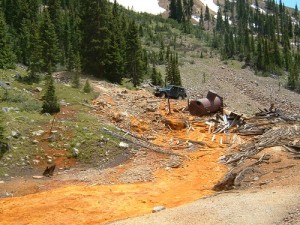 The Good Samaritan Legislation would address the current pollution clean-up laws in the United States. Currently, the Clean Water Act and the Comprehensive Environmental Response, Compensation, and Liability Act, place the clean-up burden on the property owners. But in the case of these abandoned mines, the owners are long-gone. Now the clean-up falls on the shoulders of Good Samaritans like TU and other partners. However, the liabilities in the laws- requiring a project to show significant improvements for a specific period of time and makes the Good Samaritan liable for any failures in improvements- have caused a legal gridlock.
The Good Samaritan Legislation would address the current pollution clean-up laws in the United States. Currently, the Clean Water Act and the Comprehensive Environmental Response, Compensation, and Liability Act, place the clean-up burden on the property owners. But in the case of these abandoned mines, the owners are long-gone. Now the clean-up falls on the shoulders of Good Samaritans like TU and other partners. However, the liabilities in the laws- requiring a project to show significant improvements for a specific period of time and makes the Good Samaritan liable for any failures in improvements- have caused a legal gridlock.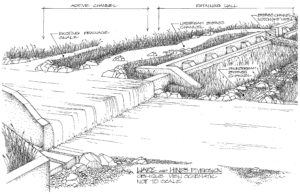 TU partnered with CPW to design and build a fish passage channel around the Ware and Hinds irrigation diversion structure on Elk Creek, a tributary to the Colorado River main-stem with its confluence at New Castle, CO. The Ware and Hinds diversion structure spans the width of the channel and presents a barrier to spawning fish moving out of the Colorado River main-stem
TU partnered with CPW to design and build a fish passage channel around the Ware and Hinds irrigation diversion structure on Elk Creek, a tributary to the Colorado River main-stem with its confluence at New Castle, CO. The Ware and Hinds diversion structure spans the width of the channel and presents a barrier to spawning fish moving out of the Colorado River main-stem The fish passage project could not have moved forward without the work from the Ferdinand-Hayden Chapter by raising $3,000 that allowed for the preliminary engineering to be completed. "This came at a critical time when I needed to finalize our design drawings," said Richard Van Gytenbeek, Colorado River Basin Outreach Coordinator. "Their contribution allowed me to pay the engineer and complete the drawings which kept the project going."
The fish passage project could not have moved forward without the work from the Ferdinand-Hayden Chapter by raising $3,000 that allowed for the preliminary engineering to be completed. "This came at a critical time when I needed to finalize our design drawings," said Richard Van Gytenbeek, Colorado River Basin Outreach Coordinator. "Their contribution allowed me to pay the engineer and complete the drawings which kept the project going."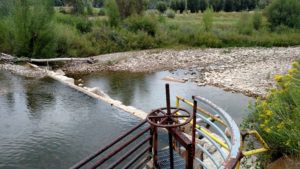 The Elk Creek passage also demonstrates the
The Elk Creek passage also demonstrates the 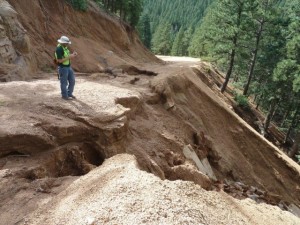 Trout populations can be negatively affected by this excessive sediment, and it can take years for these populations to recover. According to CPW, "The South Platte River in and downstream of the Hayman burn area has only recently begun to return to the quality fishery that it was prior to the fire." The Hayman fire occurred in 2002.
Trout populations can be negatively affected by this excessive sediment, and it can take years for these populations to recover. According to CPW, "The South Platte River in and downstream of the Hayman burn area has only recently begun to return to the quality fishery that it was prior to the fire." The Hayman fire occurred in 2002.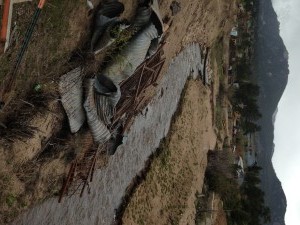
 As the Denver Metro area continues to grow, the water needs rise with it and the unreliable flows from the South Platte River aren't enough to supply roughly 80% of the state's population with water throughout the year. Which is why water from the Upper Colorado River headwaters- in this case the Fraser River- are diverted for Front Range usage.
As the Denver Metro area continues to grow, the water needs rise with it and the unreliable flows from the South Platte River aren't enough to supply roughly 80% of the state's population with water throughout the year. Which is why water from the Upper Colorado River headwaters- in this case the Fraser River- are diverted for Front Range usage.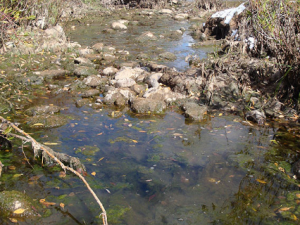 Learning by Doing requires regular monitoring of stream temperature, riparian vegetation, and aquatic macro-invertebrates. If an environmental problem is detected, Denver Water will provide some financial support and additional flows to help solve the issue. This includes providing the flushing flows the river needs in the spring to clean sediment build up.
Learning by Doing requires regular monitoring of stream temperature, riparian vegetation, and aquatic macro-invertebrates. If an environmental problem is detected, Denver Water will provide some financial support and additional flows to help solve the issue. This includes providing the flushing flows the river needs in the spring to clean sediment build up. "This project strikes a necessary balance between the water needs of Front Range municipalities and the need to protect healthy flows and fish and wildlife habitat in the Fraser River," said David Nickum, Executive Director of Colorado TU. "The so-called “Learning by Doing” program in the proposal sets up a collaborative process that requires water users to monitor the health of the river in coming years and adjust operations to address unforeseen challenges and opportunities. Moreover, Denver Water has entered into partnerships on the Front Range to ensure that the project alleviates chronic low-flow problems in South Boulder Creek. Both sides of the Divide benefit.”
"This project strikes a necessary balance between the water needs of Front Range municipalities and the need to protect healthy flows and fish and wildlife habitat in the Fraser River," said David Nickum, Executive Director of Colorado TU. "The so-called “Learning by Doing” program in the proposal sets up a collaborative process that requires water users to monitor the health of the river in coming years and adjust operations to address unforeseen challenges and opportunities. Moreover, Denver Water has entered into partnerships on the Front Range to ensure that the project alleviates chronic low-flow problems in South Boulder Creek. Both sides of the Divide benefit.”
